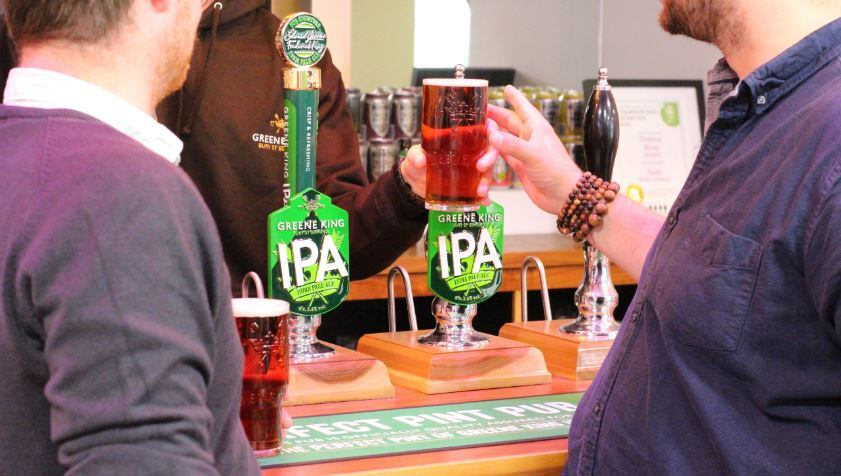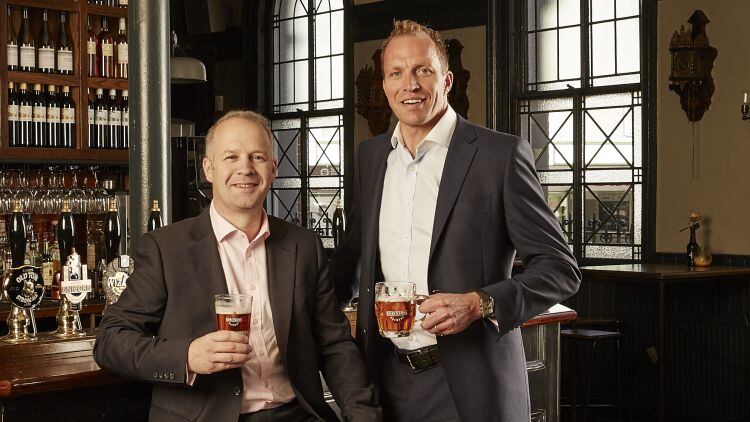Customer service checklist
- Always welcome guests with a smile and a greeting
- Aim for consistency of serve through the day, every day
- Organise the bar efficiently and have appropriate staff levels to provide speedy service when busy
- Recruit staff with good people skills for customer-facing roles
- Train staff in core customer service values and monitor implementation
- Nurture a service ethic throughout all roles including back of house
- Positive customer interaction should be sincere and unforced
- Offer more: “is there anything else I can get you?” is better than “is your food all right?”
- Don’t overdo it: if all’s good, leave them alone
- Empower staff to implement appropriate service recovery when necessary
- Acknowledge departure: service doesn’t stop once you’ve taken the money
- Monitor reviews and invite customer feedback

Early weekday evening in a pub in central Manchester. A customer orders a meal at the bar and asks if they can substitute skinny fries for another dish’s thick-cut chips.
The server refuses: the EPoS can’t cope, nor can the kitchen. It’s a new menu that day. Perhaps in a few days it will be possible once it’s bedded in – but not tonight.
The customer pleads; the server is immovable. There’s some eye-rolling, but from the latter not the former. After some too-ing and fro-ing, the customer beats a retreat to their table, defeated. The server attempts to recruit the support of another customer by blaming their wait on the first customer’s awkwardness.
It’s unlikely the first customer – dissatisfied if not humiliated – will be back to test the promised brave new future of menu swap options that’s been prophesied. The server’s victory is pyrrhic: they, the kitchen, the pubco’s training, its tech systems and, arguably, its recruitment policy have all fallen short. Added up, it’s a catastrophic failure of customer service.
The story may only concern the width of a chip, but it’s a good example of how many different aspects of organisation and execution can conspire to scupper customer satisfaction and endanger the reputation of a venue. Chelsea Hankin, head of marketing at CPL Training, which includes modules on delivering customer service in its courses, says: “Good service is about how every aspect contributes to the customer experience. You can spend a fortune on fixtures and fittings, and have a great offering, but if the interaction between customers and team members isn’t great, it takes from the experience.
“It has to be looked at in an holistic way.” In the era of online reviews and social media, customer satisfaction has become more important than ever.
Dissatisfied customers can damage a pub’s reputation far beyond the time and place that events actually take place; great customer service and smashing customers’ expectations can generate positive unsolicited publicity, though that will always be more hard won than negative feedback.
Harry Bennett, business development manager at hospitality training provider Flow, says: “If you had a really great experience you’ll go away and tell one person, but if you had a really bad one you’ll tell 10 people.”
There’s no one-size-fits-all approach to service. It might mean speed to one customer, while to another it’s taking the time to chat and slowing things down.
Brewhouse & Kitchen group operations director Mark McFadyen says staff need to be able to read what a customer wants.
“We do training around pre-emptive service, trying to engage with the customer to get an idea of what their needs might be,” he says. “It’s important to understand what people want. That means staff getting to know customers quickly and asking: ‘What can I do to make this person’s experience better?’. Essentially, our whole customer service ethos is around the idea of creating happiness, in whatever form that may take.”
Bennett at Flow says that a consistent approach is important.
“It’s ensuring that everybody receives the same attention, energy and passion from the staff that the business was founded on, but every operator is different and has a different vision of what that looks like.
“If you go into a bar one Saturday and order a Daiquiri and go back a week later you should get exactly the same drink served in exactly the same way, even if it’s by a different bartender.”
Frankie Griffiths, general manager at the Drawing Board in Leamington Spa, Warwickshire, says recruiting people with the right people skills and giving them the flexibility to make decisions is key.
“We are an independent so there aren’t lots of rules and regulations about what they can do,” she says.
“We actively recruit staff with a bit of personality who can judge within the first 10 seconds whether you can have some fun with customers or need to take a more serious approach.
“If there are dietary requirements that aren’t straightforward, the chefs are approachable and able to cater for that.
“If it’s a special occasion we’ll go the extra mile to make sure they’re spoilt and made to feel special. It’s a very personal level of service and what works for one table isn’t going to work for all.”
Hankin at CPL says the horses-for-courses approach applies to different brands or styles of outlet too.
“There are some fundamentals that are undebatable across the board,” she says, “but the detail of your service needs to reflect your proposition.
“If you have a premium brand or product, your service has to reflect that. It includes how your people communicate with the customer. Are they showing welcoming and open body language? Are they using the correct greeting? Even the tone of that can change according to the outlet. In a premium pub it might be ‘good evening sir’; in casual dining it might be more ‘hi, how are you?’.”
Diageo GB’s Bar Academy on-trade consultant Rob Poulter says proper bar organisation leads to speedy service, a key aspect of customer satisfaction at busy times.
“Every bottle, ingredient and piece of equipment should be within easy reach of the bartender’s workstation,” he says. “Remove clutter. This helps them to work better and helps facilitate customer choice.”
The right stuff
The good customer service journey starts with getting the right people in the first place.
“A lot comes down to the recruitment process,” says Bennett at Flow. “By looking at their interests outside work you can paint a picture of what kind of person they are. You can tell if someone’s fun and outgoing and their attitude’s right.”
Griffiths at the Drawing Board agrees.
“When you’re interviewing people you get a sense of someone’s character,” she says. “We’ve got a few older members of staff, in their 40s who are parents and they sometimes seem to get things to another level of customer service, perhaps because they have more experience of being customers themselves.”
But while good people skills may be innate, there’s always room for improvement, which is where including customer service in training regimes comes in.
“Good service can be taught,” says Griffiths, “though common sense is one thing that can’t be. We have an order of service involving welcoming customers into the pub, getting them seated and explaining a bit about the menu, getting tap water and a drinks order if they want, so they’re made to feel comfortable and looked after immediately.”
Hankin at CPL says: “You can teach a lot of principles of customer service. People want to be sold to and be given product knowledge, such as being helped around the wine list or talked through the latest beers on tap.
Empowering staff with the right knowledge and skills to deliver great service is really important. You can train those things.
“They’ve also got to be authentic in their delivery. There’s nothing worse than trying to deliver a service experience where it feels forced.”

Errors fixed
Service recovery can often be the clincher between a customer leaving happy or unhappy. Most people understand that pubs get busy or that mistakes are made, and will make allowances if complaints are handled well.
Griffiths at the Drawing Board says staff need to be given the power to create satisfactory outcomes.
“If someone’s had a long wait for food we try to be active rather than reactive, to communicate that we appreciate that they’ve been waiting too long and that it’s not OK, but in the meantime here’s a round of drinks or a bowl of olives.
“It doesn’t happen on a weekly basis but there are occasions where someone drops the ball and we will do whatever we can to make sure the situation is sorted out.
“If the quickest way to make sure the customer’s happy involves giving them something extra, it doesn’t need to be OK’d by a manager.”
Bennett at Flow adds: “In every industry, not just hospitality, someone messes up at some point.
“Complaint handling is often something that gets missed from training plans. We have a customer service module that has a whole section on complaint handling. It’s about the right tone of voice, not putting your hands on anyone if they’re annoyed, coming down to their level if they’re sitting down and, more than anything, listening to the customer.
“The customer is always right. All you want, at the end of the day, is for someone to go away happy and come back again with a friend, and they’re not going to do that if they’re not treated properly.”
CPL’s Hankin says: “It’s important not to get emotionally involved. Don’t take it personally if someone complains. Look to improve the situation and create a positive outcome.
“People feel like there is trust if something does go wrong and they know it’s going to be put right. They’ll feel much more likely to put their trust or loyalty into that brand.”




